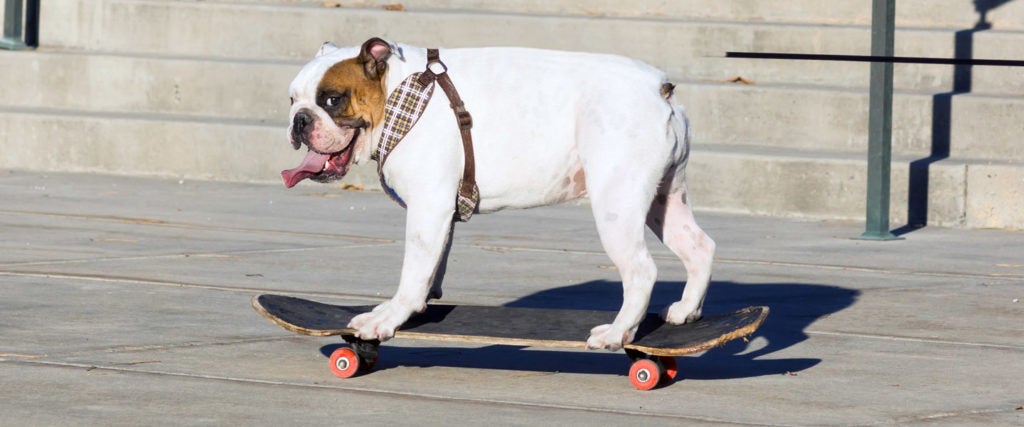We’ve all seen videos of skateboarding dogs. Their tongues flap in the wind. Their paws sling them forward. And they roll into the sunset, ready to take on the world.
It’s cute. It’s impressive. It’s certainly a sight to behold. But when I see a skateboarding dog, I can’t help but wonder, is it having fun or just doing what its owner wants?
“It’s going to depend on the dog,” says Zazie Todd, animal psychologist and author of Wag: The Science of Making Your Dog Happy. “There are a couple of questions to ask when looking at the dog. First, are they choosing to do it? If they keep showing interest in getting on the skateboard, that suggests they enjoy it. Similarly, if they’re using their paws to push themselves along, that too suggests they’re happy to be on the board.”
A dog’s body language can also tell you a lot about their happiness, including whether they’re Tony Hawk’s biggest fan. “A happy dog tends to have an open, relaxed mouth, a relaxed body and a normal posture,” says Todd. “Of course, there may be some changes to their body language due to balancing on the board, so we might not see a wide, wagging tail and a wiggly body while they’re skateboarding — but you might see that as they approach the skateboard. On the other hand, signs of stress to look for would be a low or even tucked tail, a closed mouth, a low body posture, licking the lips and the ears being pinned back.”
It’s also worth considering that skateboarding dogs may enjoy the spotlight more than the actual act of shredding the gnar. “The dogs who’ve been trained to skateboard, assuming they were trained with reward-based, positive techniques, probably reveled in the time and attention given to them by their human companions,” says Jessica Pierce, bioethicist and author of numerous books about pets. “But the skateboarding itself? I’d venture to say that many dogs don’t like it all that much, though I’m sure there are some exceptions. Also, it seems patronizing to ask an animal to do something that’s clearly outside the range of normal, species-specific behavior — like forcing a circus bear to ride a bicycle or an elephant to balance on her front feet. Why not spend the time teaching the dog to do something he or she might really enjoy, like nosework?”
However, if your dog seems like a natural Danny Way, you can certainly help them on their skateboarding journey.
How to Train Your Dog to Skateboard
“The way to train a dog to skateboard is with food as a reward — for instance, little bits of chicken, roast beef or turkey,” says Todd. “Start by very gradually getting your dog to like the board itself by giving rewards simply for approaching it. Then, teach them to put first one, and then two paws on it while you’re holding the board still. Then you can progress to moving the board very slowly — just one or two inches — and build up gradually from there.”
“Always give your dog a choice and encourage them; don’t force them,” Todd continues. “Making the training fun and following a gradual training plan will help your dog to enjoy it.”
If you suspect your dog can be a skateboarding legend, and they seem into it, starting them early can help as well. “It will be easier if your dog had the chance to get used to skateboards as a puppy,” Todd explains. “Some puppy classes include giving the puppies the opportunity to approach a skateboard and investigate it to teach them that it’s okay. This is helpful because when puppies are in the sensitive period of socialization, from three until 12 to 14 weeks, positive experiences help them learn about the world.”
I’ll keep an eye out for the video of your pooch pulling a McTwist.

